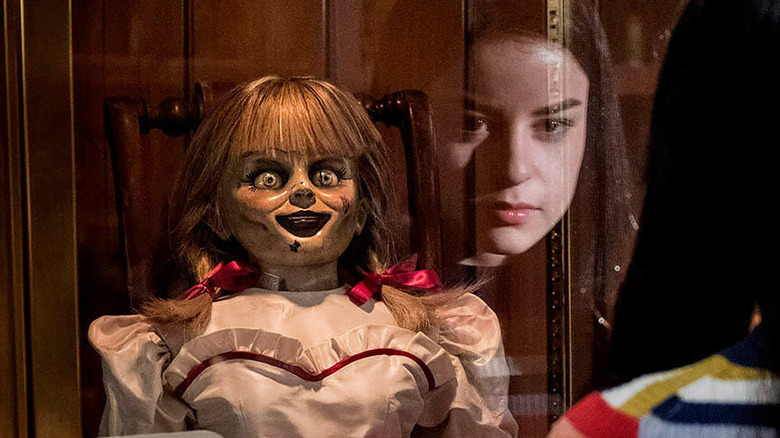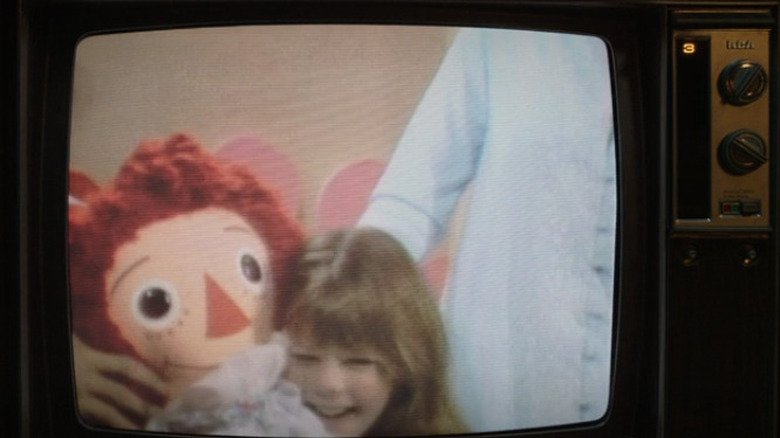The Annabelle Comes Home Easter Egg That Pays Homage To The Original Doll
The first image shown in James Wan's 2013 horror film "The Conjuring" is of a doll. The doll is weathered (but not necessarily well-loved), with scratches on its blushed cheekbone and worn-away eyelash paint peering out from under blunt red bangs. A crack splits the iris of the toy's eye, perhaps allowing a peek into something nasty hidden within the porcelain conduit. The doll is introduced during an interview with the Warrens (played by Vera Farmiga and Patrick Wilson), a married paranormal investigation team. Then and throughout the "Conjuring" films, this doll — called Annabelle — is a ginger menace who wreaks havoc and racks up a body count wherever it goes.
It's fairly common knowledge (at least, among horror heads) that the real allegedly-haunted Annabelle doesn't have such an overtly creepy look. She is a Raggedy Ann, from a popular line of dolls; this writer had a non-haunted one as a kid. Similar to the Annabelle of "The Conjuring," the doll was brought to the Warrens with complaints of aggressive, malevolent behavior, to which the Warrens concluded that the toy was demonically possessed and encased it in a glass box (blessed by a priest) in their now-closed Occult Museum in Monroe, Connecticut. Seven sequels and spin-offs later throughout the Conjuring Universe (which includes Annabelle films, Conjuring films, "The Nun," and "The Curse of La Llorona"), the Annabelle doll has become a fixture in modern horror iconography, right next to The Babadook. But within the "Annabelle" spinoffs, a Raggedy Ann makes a cameo for eagle-eyed viewers to enjoy.
The real thing isn't so scary
Released in 2019, "Annabelle Comes Home" is the third "Annabelle" film within the "Conjuring"-verse. Gary Dauberman writes and directs, pulling from the world established by Wan from 2014 onward to include the doll's onscreen history as a lil' Bad News Bear. Thanks to the carelessness of one crummy kid, Annabelle's case is left unlocked and the doll, possessed by a demon posing as Annabelle "Bee" Mullins (see "Annabelle: Creation").
Partway through "Annabelle Comes Home," young Judy Warren (McKenna Grace), daughter of Ed and Lorraine, is watching tv, and sees a game show wherein a contestant wins a doll – and that doll is a Raggedy Ann. Considering the real-life accounts given by the Warrens, it's an intentional, cheeky nod to the original claims and material.
The Raggedy Ann version of Annabelle was, according to the demonologist couple, moved to their home and Occult Museum in 1970 following a complaint from a student nurse and her roommate, who allege strange goings-on whenever the doll was present. Naturally, the same society and culture that eats up creepy doll stories like Don Mancini's "Child's Play" and Talky Tina of "The Twilight Zone" (Bonus: guess what the mother's name was in that episode, titled "Living Doll") became fascinated with assertions of a demonically-occupied rag doll, whether you believe the story or not. Which is spookier: the theatrical doll or the real thing?

